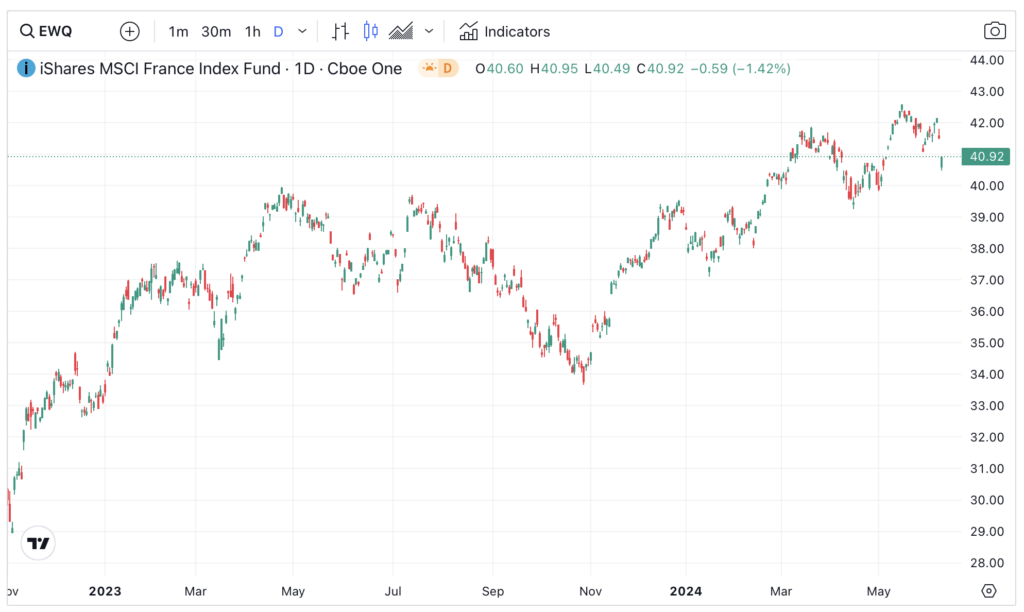France sent shockwaves through the market on Monday when president Macron called a snap legislative election the previous evening. “France,” he asserted boldly, “needs a clear majority in serenity and harmony. To be French, at heart, is about choosing to write history, not being driven by it.” The reason for this sudden political decision was to break National Rally’s momentum. This party scored highly in the recent European elections.
All eyes on French and British Elections
Political uncertainties always weigh on markets. The French stock market gapped down on Monday, although losses were partially clawed back by the end of the session. The iShares MSCI France ETF (US:EWQ) remains on an upward trajectory, delineated by the pattern of rising lows (see below).
Not to forget is the looming general election in the UK. Later this year, the US will be holding the four-year presidential election.
Generally, stock markets in Europe and US are still in a bullish mood. This can be seen from the richly-valued Magnificent Seven companies (three three-trillion companies!). Even UK IPOs are doing reasonably well. Raspberry Pi’s (RPI) IPO this week brought some smiles to shareholders today as prices jumped 25 percent from initial pricing of 280p.
What could break the bullish sentiment in the stock market? For now, there is a notable absence of fear. Stock prices could well continue to trend higher as investors rejoice from lower interest rates. Even these turbulent political events are not really denting investor’s positive outlook. No one seems to be in a hurry to sell their stock portfolios.

Bonds, on the other hand, are struggling.
Many long-dated government bonds have failed to capitalise on the buoyant sentiment in the stock market. This is because of sticky inflation data, much stickier than anticipated. The rebound in bond prices late last year was broadly not sustained. For example, the iShares 7-10 Bond ETF (IEF) rose from 88 to 97 in a matter of weeks before going on a long, multi-quarter slide. Recent economic data capped its upside. Yes, the Fed is still expected to cut rates, but on a much smaller scale.
This negative bond trend is also observed in the UK (see, eg, iShares UK Gilts (IGLT)). Debt yields are staying higher for longer. The economic impact of this is not to be underestimated. UK mortgage arrears is recently estimated at 7-year high.
This begs the question, could high bond yields be the ultimate market breaker?
Possibly, but these borrowing costs may need to go up further from here in order to increase financial pressure on governments, households, and corporations. US stock markets have been climbing to new highs despite the rise in rates. Market participants are digesting the end of QE (zero interest rates policy) and are adapting well to the new investment landscape.
At this rate, pressure on bonds may continue. The pattern of falling reaction highs is clear on bonds’ charts, which means that new long-term lows are possible. Therefore tread carefully when buying long-maturity government bonds.


Jackson is a core part of the editorial team at GoodMoneyGuide.com.
With over 15 years of industry experience as a financial analyst, he brings a wealth of knowledge and expertise to our content and readers.
Previously, Jackson was the director of Stockcube Research as Head of Investors Intelligence. This pivotal role involved providing market timing advice and research to some of the world’s largest institutions and hedge funds.
Jackson brings a huge amount of expertise in areas as diverse as global macroeconomic investment strategy, statistical backtesting, asset allocation, and cross-asset research.
Jackson has a PhD in Finance from Durham University and has authored over 200 guides for GoodMoneyGuide.com.
You can contact Jackson at jackson@goodmoneyguide.com




